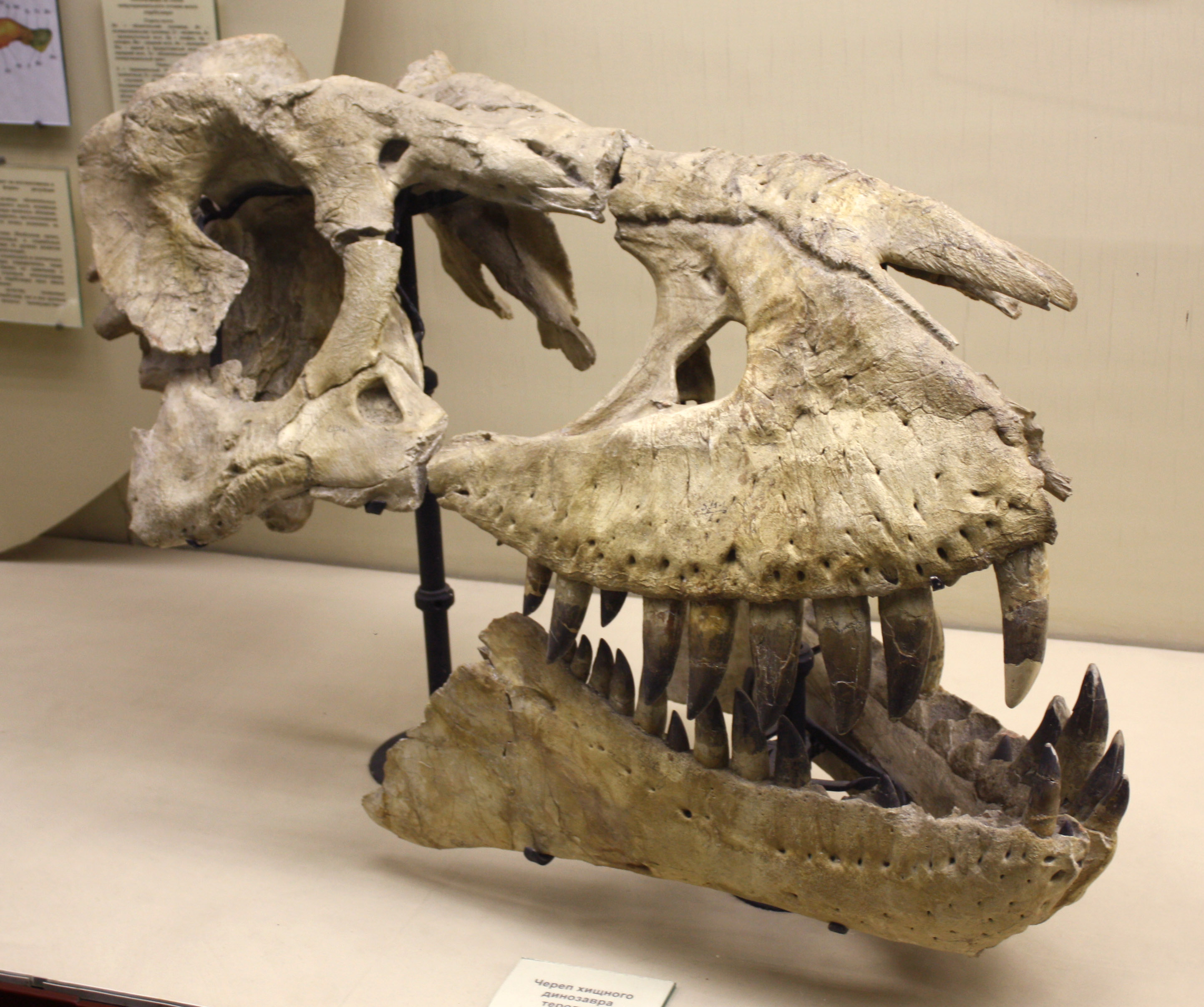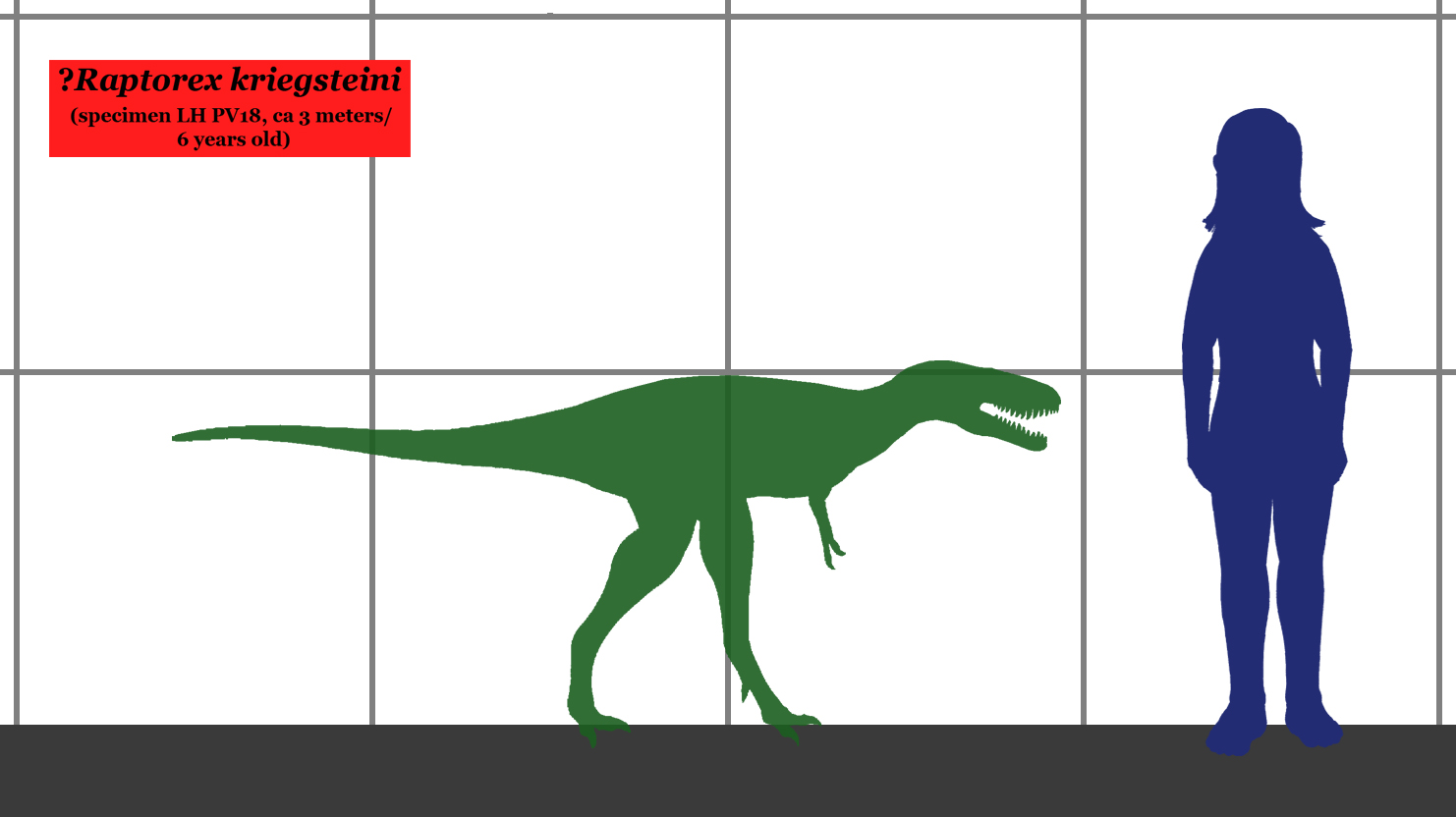|
Tarbosaurus
''Tarbosaurus'' ( ; meaning "alarming lizard") is a genus of tyrannosaurid dinosaur that flourished in Asia about 70 million years ago, at the end of the Late Cretaceous Period, considered to contain a single known species, ''Tarbosaurus bataar''. Fossils have been recovered from the Nemegt Formation of Mongolia, with more fragmentary remains found further afield in the Subashi Formation of China. Although many species have been named, modern paleontologists recognize only one, ''T. bataar'', as valid. Some experts see this species as an Asian representative of the North American genus ''Tyrannosaurus''; this would make the genus ''Tarbosaurus'' redundant. ''Tarbosaurus'' and ''Tyrannosaurus'', if not synonymous, are considered to be at least closely related genera. ''Alioramus'', also from Mongolia, has previously been thought by some authorities to be the closest relative of ''Tarbosaurus'', though this has since been disproven with the discovery of '' Qianzhousaurus'' and ... [...More Info...] [...Related Items...] OR: [Wikipedia] [Google] [Baidu] |
Tyrannosaurid
Tyrannosauridae (or tyrannosaurids, meaning "tyrant lizards") is a family of coelurosaurian theropod dinosaurs that comprises two subfamilies containing up to thirteen genera, including the eponymous ''Tyrannosaurus''. The exact number of genera is controversial, with some experts recognizing as few as three. All of these animals lived near the end of the Cretaceous Period and their fossils have been found only in North America and Asia. Although descended from smaller ancestors, tyrannosaurids were almost always the largest predators in their respective ecosystems, putting them at the apex of the food chain. The largest species was ''Tyrannosaurus rex'', one of the largest and most massive known land predators, which measured over in length and according to most modern estimates to in weight. Tyrannosaurids were bipedal carnivores with massive skulls filled with large teeth. Despite their large size, their legs were long and proportioned for fast movement. In contrast, their ... [...More Info...] [...Related Items...] OR: [Wikipedia] [Google] [Baidu] |
Alioramus
''Alioramus'' (; meaning 'different branch') is a genus of tyrannosaurid theropod dinosaurs from the Late Cretaceous period of Asia. It currently contains two species. The type species, ''A. remotus'' is known from a partial skull and three foot bones recovered from the Mongolian Nemegt Formation, which was deposited in a humid floodplain about 70 million years ago. These remains were named and described by Soviet paleontologist Sergei Kurzanov in 1976. A second species, ''A. altai'', known from a much more complete skeleton also from the Nemegt Formation, was named and described by Stephen L. Brusatte and colleagues in 2009. Its relationships to other tyrannosaurid genera were at first unclear, with some evidence supporting a hypothesis that ''Alioramus'' was closely related to the contemporary species ''Tarbosaurus bataar''. However, the discovery of ''Qianzhousaurus'' indicates that it belongs to a distinct branch of tyrannosaurs, namely the tribe Alioramini. ''Alioramu ... [...More Info...] [...Related Items...] OR: [Wikipedia] [Google] [Baidu] |
Tyrannosaurus
''Tyrannosaurus'' is a genus of large theropoda, theropod dinosaur. The species ''Tyrannosaurus rex'' (''rex'' meaning "king" in Latin), often called ''T. rex'' or colloquially ''T-Rex'', is one of the best represented theropods. ''Tyrannosaurus'' lived throughout what is now western North America, on what was then an island continent known as Laramidia. ''Tyrannosaurus'' had a much wider range than other Tyrannosauridae, tyrannosaurids. Fossils are found in a variety of geologic formation, rock formations dating to the Maastrichtian Age (geology), age of the Upper Cretaceous Period (geology), period, 68 to 66 mya (unit), million years ago. It was the last known member of the tyrannosaurids and among the last non-aves, avian dinosaurs to exist before the Cretaceous–Paleogene extinction event. Like other tyrannosaurids, ''Tyrannosaurus'' was a bipedal carnivore with a massive skull balanced by a long, heavy tail. Relative to its large and powerful hind limbs, the foreli ... [...More Info...] [...Related Items...] OR: [Wikipedia] [Google] [Baidu] |
Nemegt Formation
The Nemegt Formation (also known as Nemegtskaya Svita) is a geological formation in the Gobi Desert of Mongolia, dating to the Late Cretaceous. The formation consists of river channel sediments and contains fossils of fish, turtles, crocodilians, and a diverse fauna of dinosaurs, including birds. Description The Nemegt Formation is composed of mudstones and sandstones that were deposited by ancient lakes, streams, and flood plains. The Altan Uul locality was described by Michael Novacek as "a canyon carved out of a very rich series of sedimentary rocks" with "steep cliffs and narrow washes". The climate associated with it was wetter than when preceding formations were deposited; there seems to have existed at least some degree of forest cover. Fossilized trunks have been also found. These petrified wood, and the remains of Araucariaceae conifers indicate that the forests of the Nemegt were thickly wooded, with a high canopy formed by tall conifer trees. When examined, the rock ... [...More Info...] [...Related Items...] OR: [Wikipedia] [Google] [Baidu] |
Raptorex Kriegsteini
''Raptorex'' is a dubious genus of tyrannosaurid dinosaur. Its fossil remains consist of a single juvenile specimen probably uncovered in Mongolia, or possibly northeastern China. The type species is ''R. kriegsteini'', described in 2009 by Sereno and colleagues. The genus name is derived from Latin ', "robber", and ', "king". The specific name honours Roman Kriegstein, a survivor of the Holocaust, whose son Henry Kriegstein donated the specimen to the University of Chicago for scientific study. While initially considered to have come from the Yixian Formation of China, dated to approximately 125 million years ago during the early Cretaceous period, later studies showed that such an early date for the fossil are unlikely, and given its extremely close similarity to juvenile tyrannosaurids of the late Cretaceous, it probably came from the Nemegt or similar formation. Because the specimen is a juvenile, and the changes undergone by tyrannosaurids during growth are not yet well u ... [...More Info...] [...Related Items...] OR: [Wikipedia] [Google] [Baidu] |
Raptorex
''Raptorex'' is a dubious genus of tyrannosaurid dinosaur. Its fossil remains consist of a single juvenile specimen probably uncovered in Mongolia, or possibly northeastern China. The type species is ''R. kriegsteini'', described in 2009 by Sereno and colleagues. The genus name is derived from Latin ', "robber", and ', "king". The specific name honours Roman Kriegstein, a survivor of the Holocaust, whose son Henry Kriegstein donated the specimen to the University of Chicago for scientific study. While initially considered to have come from the Yixian Formation of China, dated to approximately 125 million years ago during the early Cretaceous period, later studies showed that such an early date for the fossil are unlikely, and given its extremely close similarity to juvenile tyrannosaurids of the late Cretaceous, it probably came from the Nemegt or similar formation. Because the specimen is a juvenile, and the changes undergone by tyrannosaurids during growth are not yet well u ... [...More Info...] [...Related Items...] OR: [Wikipedia] [Google] [Baidu] |
Gorgosaurus
''Gorgosaurus'' ( ; ) is a genus of tyrannosaurid theropod dinosaur that lived in western North America during the Late Cretaceous Period (Campanian), between about 76.6 and 75.1 million years ago. Fossil remains have been found in the Canadian province of Alberta and the U.S. state of Montana. Paleontologists recognize only the type species, ''G. libratus'', although other species have been erroneously referred to the genus. Like most known tyrannosaurids, ''Gorgosaurus'' was a large bipedal predator, measuring in length and in body mass. Dozens of large, sharp teeth lined its jaws, while its two-fingered forelimbs were comparatively small. ''Gorgosaurus'' was most closely related to ''Albertosaurus'', and more distantly related to the larger ''Tyrannosaurus''. ''Gorgosaurus'' and ''Albertosaurus'' are extremely similar, distinguished mainly by subtle differences in the teeth and skull bones. Some experts consider ''G. libratus'' to be a species of ''Albertosaurus''; thi ... [...More Info...] [...Related Items...] OR: [Wikipedia] [Google] [Baidu] |
Albertosaurus
''Albertosaurus'' (; meaning "Alberta lizard") is a genus of tyrannosaurid theropod dinosaurs that lived in western North America during the Late Cretaceous Period, about 71 million years ago. The type species, ''A. sarcophagus'', was apparently restricted in range to the modern-day Canadian province of Alberta, after which the genus is named, although an indeterminate species ("cf. ''Albertosaurus'' sp.") has been discovered in the Corral de Enmedio and Packard Formations in Mexico. Scientists disagree on the content of the genus, with some recognizing ''Gorgosaurus libratus'' as a second species. As a tyrannosaurid, ''Albertosaurus'' was a bipedal predator with tiny, two-fingered hands and a massive head that had dozens of large, sharp teeth. It may have been an apex predator in its local ecosystem. While ''Albertosaurus'' was large for a theropod, it was much smaller than its larger and more famous relative ''Tyrannosaurus rex'', growing up to in length and weighing . ... [...More Info...] [...Related Items...] OR: [Wikipedia] [Google] [Baidu] |
Subashi Formation
The Subashi Formation () is a Late Cretaceous (Campanian to Maastrichtian)Xi et al., 2018 formation from the Xinjiang Autonomous Region of western China.Subashi Formation at Fossilworks.org Initially described by in 1977, the formation contains remains of '''' which were initially described as a separate taxon '' Shanshanosaurus huoyanshanensis ... [...More Info...] [...Related Items...] OR: [Wikipedia] [Google] [Baidu] |
Evgeny Maleev
Evgeny Aleksandrovich Maleev (, ; 25 February 1915 – 12 April 1966) was a Soviet and Russian paleontologist who did most of his research on reptiles and Asian fossils, such as the naming of the ankylosaur ''Talarurus'' and theropods ''Tarbosaurus'' and ''Therizinosaurus'' along with the family Therizinosauridae. Biography Evgeny Aleksandrovich Maleev was born on February 25, 1915, in the Russian Empire. After being a member on the Eastern Front (World War II) he started his scientific career at the Moscow State University. In 1947 he graduated from the Faculty of Biology, also in that year, he started to work at the Paleontological Institute, Russian Academy of Sciences. In 1950 Maleev presented his PhD thesis, "Morphofunctional analysis of the occipital region of the skull and skeleton of the neck of mammals", being awarded the Candidate of Sciences. Later on, he worked as the deputy manager from 1956 to 1962. He also was the leader of an expedition conducted in 1962 to In ... [...More Info...] [...Related Items...] OR: [Wikipedia] [Google] [Baidu] |
1955 In Paleontology
Plants Pteridophyta Dinosaurs * ''Massospondylus'' gastroliths are documented.Bond (1955). Sanders, Manley, and Carpenter (2001), "Table 12.1" page 167. Newly named dinosaurs Data courtesy of George Olshevsky's dinosaur genera list. Synapsids Theriodonts Eutherians Cetaceans References {{portal, Paleontology * Bond, G. 1955. A note on dinosaur remains from the Forest Sandstone (Upper Karoo). Occasional Papers of the National Museum of Rhodesia 2: 795–800. * Sanders F, Manley K, Carpenter K. Gastroliths from the Lower Cretaceous sauropod Cedarosaurus weiskopfae. In: Tanke D.H, Carpenter K, editors. Mesozoic vertebrate life: new research inspired by the paleontology of Philip J. Currie. Indiana University Press; Bloomington, IN: 2001. pp. 166–180. 1950s in paleontology Paleontology Paleontology (), also spelled palaeontology or palæontology, is the scientific study of life that existed prior to, and sometimes including, the start of the Holocene epoch ... [...More Info...] [...Related Items...] OR: [Wikipedia] [Google] [Baidu] |
Deinodon
''Deinodon'' (Greek for "terrible tooth") is a dubious tyrannosaurid dinosaur genus containing a single species, ''Deinodon horridus''. ''D. horridus'' is known only from a set of teeth found in the Late Cretaceous Judith River Formation of Montana and named by paleontologist Joseph Leidy in 1856.Leidy, J. (1856). "Notices of the remains of extinct reptiles and fishes, discovered by Dr. F.V. Hayden in the badlands of the Judith River, Nebraska Territory." ''Proc. Acad. Nat. Sci.'', 8(2): 72. These were the first tyrannosaurid remains to be described and had been collected by Ferdinand Vandeveer Hayden. The teeth of ''Deinodon'' were slightly heterodont, and the holotype of ''Aublysodon'' can probably be assigned to ''Deinodon''. History and classification It is likely that the fossilized teeth of ''D. horridus'' belonged to the dinosaur later identified as ''Gorgosaurus libratus''. In a 1922 study, William Diller Matthew & Barnum Brown found that the teeth of ''D. horridus'' and ' ... [...More Info...] [...Related Items...] OR: [Wikipedia] [Google] [Baidu] |








